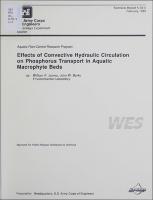Please use this identifier to cite or link to this item:
https://hdl.handle.net/11681/6377| Title: | Effects of convective hydraulic circulation on phosphorus transport in aquatic macrophyte beds |
| Authors: | James, William F., Aquatic biologist Barko, John W. |
| Keywords: | Convection Climate Hydrology Limnology Littoral zone Macrophytes Phosphorus Phytoplankton Sediment Solutes Temperature Biogeochemical cycles Reservoirs Ecology Aquatic Plant Control Research Program (U.S.) |
| Publisher: | U.S. Army Engineer Waterways Experiment Station |
| Series/Report no.: | Technical Report (Aquatic Plant Control Research Program (U.S.)) ; no.Technical Report A-93-4 |
| Abstract: | Phosphorus (P) dynamics in aquatic macrophyte beds and P exchanges between littoral and pelagic zones, driven by nighttime convective circulation, were examined in Eau Galle Reservoir, Wisconsin, during summer 1989. Rates of P release from littoral sediments, measured in laboratory incubation systems, increased in a linear fashion with pH under both aerobic and anaerobic conditions. Estimated rates of P release from littoral zone sediments, based on field measurements of pH and oxygen, averaged 3.6 mg m⁻² day⁻¹ under aerobic conditions, and were in close agreement with independently determined diffusional fluxes across the littoral sediment interface. Marked vertical gradients in P developed during the summer in bottom waters of the littoral zone. The littoral zone, dominated by submersed macrophytes, cooled more rapidly at night than the pelagic zone on 72 percent of midsummer days (June-August), promoting nighttime convective circulation. Based on patterns of dye dispersion during these periods of circulation, cooler littoral bottom water originating within macrophyte beds moved into the pelagic zone as an interflow confined to the base of the epilimnion, while warmer pelagic water moved into the littoral zone as a surface flow. Hourly volumetric flow rates were linearly related to mean negative horizontal temperature gradients that developed during the night. Net TP flux from the littoral to the pelagic zone ranged from 0.12 to 0.43 mg m⁻² hr⁻¹ and averaged 0.22 mg m⁻² hr⁻¹ for the summer. Nighttime convective circulation appears to be an important mechanism for movement of littoral P from macrophyte beds to the pelagic zone in this reservoir. |
| Description: | Technical Report |
| Gov't Doc #: | Technical Report A-93-4 |
| Rights: | Approved for public release; distribution is unlimited |
| URI: | http://hdl.handle.net/11681/6377 |
| Appears in Collections: | Technical Report |
Files in This Item:
| File | Description | Size | Format | |
|---|---|---|---|---|
| TR-A-93-4.pdf | Technical Report A-93-4 | 4.69 MB | Adobe PDF |  View/Open |